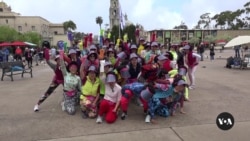ພວກແມ່ຍິງກາງໄວ ສ່ວນຫຼາຍຮູ້ສຶກຄືວ່າ ພວກເຂົາເຈົ້າບໍ່ຄ່ອຍໄດ້ຍິນຫຼືເຫັນ ໃນບົດບາດຕ່າງໆຂອງຕົນ ໃນຖານະເປັນ ພັນລະຍາ ແລະມານດາ. ໃນພາກໃຕ້ຂອງລັດຄາລີຟໍເນຍ ກຸ່ມນັກເຕັ້ນຊາວເກົາຫຼີກຸ່ມນຶ່ງ ພວກອອກມາເພື່ອປ່ຽນທັດສະນະຄະຕິທັງຫຼາຍເຫຼົ່ານັ້ນ.
ທຸກລະດູບານໃໝ່ ກຸ່ມນັກເຕັ້ນກຸ່ມນຶ່ງ ທີ່ນຸ່ງຊຸດມີສີສັນໄດ້ນັດກັນອອກມາເຕັ້ນຢູ່ຕາມສະຖານທີ່ສາທາລະນະ ໃນນະຄອນແຊນດີເອໂກ. ບໍ່ມີຜູ້ໃດເລີຍທີ່ເປັນນັກເຕັ້ນອາຊີບ ຫຼື ມີອາຍຸຕ່ຳກວ່າ 40 ປີ. ພວກເຂົາເຈົ້າເອີ້ນກຸ່ມນີ້ ວ່າ “ອາຈຸມມາ,” ນາງ ພໍລາ ຄິມ ນັກສະແດງຜູ້ນຶ່ງກ່າວ.
ນາງພໍລາ ຄິມ ກ່າວວ່າ “‘ອາຈຸມມາ’ ແມ່ນຄຳສັບພາສາເກົາຫຼີສຳລັບພວກແມ່ ຍິງໄວກາງຄົນ ລະຫວ່າງ 30 ປີ ຫາ 60 ປີ ຜູ້ທີ່ມີລູກສອງສາມຄົນ ຜູ້ທີ່ແຕ່ງ ງານແລ້ວ ແລະຄຳສັບນີ້ກາຍມາເປັນຄຳທີ່ບໍ່ຄ່ອຍດີສຳລັບບາງຄົນທີ່ບໍ່ກ່ຽວຂ້ອງ ຫຍັງເລີຍ ເຊັ່ນວ່າ: ແມ່ຍິງໄວກາງຄົນຜູ້ທີ່ພຽງແຕ່ດຳລົງຊີວິດໃນໂລກນີ້ ເພື່ອເບິ່ງແຍງຄົນອື່ນໆ ແລະບໍ່ແມ່ນບຸກຄົນຜູ້ດຽວ.”
ກຸ່ມນີ້ໄດ້ເລີ້ມຕົ້ນຂຶ້ນ ໃນປີ 2017 ເພື່ອປ່ຽນພາບພົດອັນນັ້ນ ນາງລີ ແອນ ຄິມ ຜູ້ຮ່ວມກໍ່ຕັ້ງກຸ່ມກ່າວ.
ນາງ ລີ ແອນ ຄິມ ກ່າວວ່າ “ເປັນຫຍັງຈຶ່ງຖືກເອີ້ນວ່າ ໄວກາງຄົນ, ເປັນຫຍັງ ມັນຈຶ່ງເຮັດໃຫ້ເຈັບຊ້ຳໃຈ ຫຼືກຽດຊັງ? ພວກເຮົາພຽງແຕ່ຢາກປ່ຽນຄວາມໝາຍໃນສິ່ງທີ່ມັນໝາຍເຖິງ ການເປັນໄວກາງຄົນເທົ່ານັ້ນ. ພວກຄົນເຂົາຄິດວ່າ ຂະນະທີ່ເຈົ້າມີອາຍຸຫຼາຍຂຶ້ນ ຄືວ່າ ສິ່ງດີໆມັນຜ່ານພົ້ນໄປແລ້ວ ແຕ່ພວກເຮົາມາທີ່ນີ້ເພື່ອບອກວ່າ ‘ສິ່ງດີສຸດຍັງບໍ່ທັນມາເທື່ອ.”
ຮູບຊົງຂອງ ອາຈຸມມາ ລວມມີຜົມດັດສັ້ນ-ທີ່ເໝາະສົມສຳລັບແມ່ຍິງທີ່ມີວຽກ ຫຼາຍ; ມີຊີວິດຊີວາ ແລະໃສ່ຊຸດທີ່ມີສີສັນປົນກັນໄປ; ໃສ່ເສື້ອກັກຫຼາຍຖົງທີ່ເປັນ ເອກະລັກຂອງຕົນ; ກະເປົາຮັດແອວ; ໝວກກັນແດດ; ແລະເພື່ອໃຫ້ເຂົ້າກັບ ຄວາມຕາລົກ-ຕ້ອງມີຖົງມືລ້າງຖ້ວຍ. ຄູ່ຮ່ວມກໍ່ຕັ້ງກຸ່ມ ນາງໂຊເນຍ ຈິນ ກ່າວວ່າ ຮູບຊົງນີ້ ໃຫ້ກຽດແດ່ພວກອາຈຸມມາທັງຫຼາຍ ໃນເກົາຫຼີ ເມື່ອຊຸມປີ 1980.
ນາງໂຊເນຍ ຈິນ ກ່າວວ່າ “ອາຈຸມມາຢູ່ທີ່ນັ້ນ ໄດ້ເຮັດວຽກຢ່າງຈິງຈັງ, ເຮັດ ວຽກຍາກລຳບາກແທ້ໆ ເພື່ອຊ່ວຍຄອບຄົວຂອງນາງ ໃຫ້ຜ່ານຜ່າຫຼັງສົງຄາມ ເກົາຫຼີ, ຕໍ່ຈາກນັ້ນມາ ກໍມີເສດຖະກິດຝືດເຄືອງໃນເກົາຫຼີ. ນາງຕ້ອງໄດ້ອອກໄປ ຈາກເຮືອນ ແລະຕ້ອງມີທຸລະກິດຂອງຕົນເອງ ເພື່ອນຳເອົາເງິນເຂົ້າມາໃຫ້ຄອບ ຄົວ, ແລ້ວໃນຂະນະທີ່ເຮັດທຸກສິ່ງທຸກຢ່າງນັ້ນ ນາງຍັງຕ້ອງໄດ້ເບິ່ງແຍງຄອບ ຄົວຂອງສາມີພ້ອມ, ນາງໄດ້ລ້ຽງພວກລູກເຕົ້າ, ນາງຍັງໄດ້ສະໜັບສະໜູນ ສາມີຂອງນາງນຳດ້ວຍ.”
ກຸ່ມອາຈຸມມາໃນມື້ນີ້ ມີສະມາຊິກຫຼາຍກວ່າ 40 ຄົນ ທີ່ມາຈາກພື້ນຖານຊົນຊາດ ທີ່ແຕກຕ່າງກັນ. ນາງ ແມລເວຍ ສຕຣິກແລນ ໄດ້ເຂົ້າຮ່ວມກຸ່ມ ຫຼັງຈາກທີ່ໄດ້ ຍົກຍ້າຍມາຢູ່ເຂດພາກໃຕ້ຂອງລັດຄາລີຟໍເນຍ ຈາກພາກຕາເວັນຕົກຕອນກາງ.
ນາງ ສຕຣິກແລນ ນັກສະແດງຄົນນຶ່ງກ່າວວ່າ “ຂ້ອຍບໍ່ມີໝູ່ເພື່ອນເລີຍ ຕອນທີ່ ຍ້າຍມາຢູ່ທີ່ນີ້ເມື່ອສີ່ປີກ່ອນ. ມັນຄືມິດຕະພາບ. ພວກເຂົາມີແຕ່ຄວາມຮັກແພງ ກັນ ແລະພວກເຂົາມີຄວາມອົບອຸ່ນ. ແລະພວກເຂົາເຊື້ອເຊີນໃຫ້ເຂົ້າ. ພວກເຂົາ ພຽງແຕ່ເອົາຊະນະໃຈຂ້ອຍ ແລ້ວຂ້ອຍຮູ້ສຶກຕື່ນເຕັ້ນ ແລະປື້ມໃຈຫຼາຍ.”
ພວກນັກເຕັ້ນຂອງກຸ່ມອາຈຸມມາ ກ່າວວ່າ ພວກເຂົາຢາກສ້າງແຮງບັນດານໃຈ ໃຫ້ແກ່ພວກແມ່ຍິງຢູ່ໃນທົ່ວໂລກ ເພື່ອໂອບອ້ອມຮັບເອົາການເດີນທາງຂອງຊີວິດໃນທຸກໆ ໄວ.
Middle-aged women often feel like they are not seen or heard in their roles as wives and mothers. In Southern California, a Korean dance group is out to change those perceptions. Genia Dulot has the story.
Every spring, this group of brightly dressed dancers holds flash mobs at public places in San Diego. Not one of them is a professional dancer or younger than 40 years old. They are the “Ajummas,” says performer Paula Kim.
(Paula Kim, Performer)
“'Ajumma' is the Korean word for a middle-age woman between 30 and 60 who has children, who’s married, and it’s become a derogatory term for somebody who’s irrelevant: a middle-age woman who is just a person living in the world taking care of others, and not an individual.”
The group started in 2017 to change that image, says co-founder Lee Ann Kim.
(Lee Ann Kim, Ajumma Co-founder)
“Why does being called middle aged, why does it have to be hurtful or hateful? We are just re-defining what it means to be middle age. People think as you get older like best was behind you, but we are here to say, ‘The best is yet to come.’ ”
The Ajumma look includes short, permed hair — practical for a busy woman; vibrant and mismatched-on-purpose colors; pragmatic vests with lots of pockets; fanny packs; sun visors; and to complete the joke — dishwashing gloves. Co-founder Sonia Chin says the look pays tribute to ajummas in Korea in the 1980s.
(Sonia Chin, Ajumma Co-founder)
“That ajumma worked really, really hard to help her family to get through post-Korean War, then economic distress in Korea. She had to get out of the house and had to run her own business to bring some money to the family, and while doing all that, she still took care of her in-laws, she raised the kids, she was a supporter to her husband.”
The group today has more than 40 women from different ethnic backgrounds. Melvia Strickland joined after moving to Southern California from the Midwest.
(Melvia Strickland, Performer)
“I didn’t have any friends moving here four years ago. It’s friendship. They’re just lovely, and they’re warm. and they are inviting. They just won my heart, and I’m so excited and grateful.”
Ajumma dancers say they want to inspire women around the world to embrace the journey of life at every age.







ຟໍຣັມສະແດງຄວາມຄິດເຫັນ